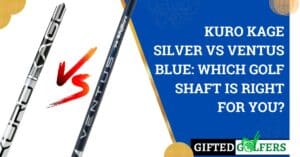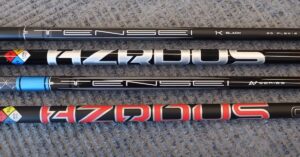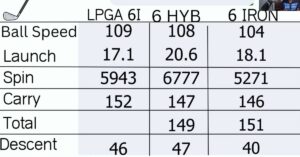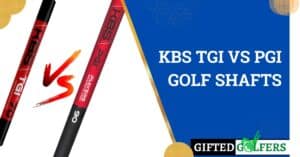Diamana BF vs Ventus Blue: Which Shaft Is Right for You?
Several key differences between the Diamana BF and Ventus Blue shafts can impact a golfer’s performance.
The main difference between Diamana BF and Ventus Blue is the launch profile: Diamana BF offers a slightly lower launch, while Ventus Blue provides a low-to-mid launch. Additionally, Diamana BF incorporates a hybrid prepreg of boron and MR70 carbon fibers for added strength and stability.
In this Diamana BF vs Ventus Blue comparison, we will explore the materials, technologies, profiles, and performance of each shaft, to help you make an informed decision on which one best suits your needs.
Diamana BF Vs Ventus Blue Shaft: What Are The Differences?
| Feature | Diamana BF Shaft | Ventus Blue Shaft |
| Materials and Technologies | DIALEAD® Pitch Fiber | VeloCore Technology |
| Shaft Profiles | Lower Launch and More Stability | Mid-Launch and Mid-Spin |
| Performance and Suitability | Precision and Consistency | Smooth Feel and VeloCore Technology |
| Construction | Exceptional Strength and Control | Optimized Energy Transfer and Straight Taper Design |
| Ball Flight | Slightly Lower Launch for Tighter Dispersion | Mid-Launch and More Active Feel |
| Compatibility with Clubheads | Compatible with a Wide Range | Designed to Boost Clubhead Performance |
| Specifications and Availability | Available in Various Flexes | Available in a Wide Range of Flexes |
Materials and Technologies
The Diamana BF series incorporates high-strength DIALEAD® Pitch Fiber by Mitsubishi Chemical into the butt-section of the shaft, adding unprecedented strength and control during shaft loading and unloading.
On the other hand, Ventus Blue shafts are developed around Fujikura’s VeloCore Technology, which maximizes energy transfer from the tip section and enhances loading and fee.
The unique materials and technologies of each shaft contribute to their distinct performance characteristics, catering to different golfing styles.
Shaft Profiles
The Diamana BF shafts are designed to offer a slightly lower launch than their B-Series counterparts, with more stability.
This can result in tighter dispersion and potentially more distance if the shaft is a good fit for your swing. In contrast, Ventus Blue shafts have a mid-launch and mid-spin profile.
They feature a slightly softer tip section, which promotes a higher launch and a more active feel, making them an excellent choice for players looking to optimize launch conditions and achieve greater carry distances.
Performance and Suitability
Diamana BF shafts are known for their stability and control during shaft loading and unloading, making them a suitable option for golfers who value precision and consistency.
Golfers with more unpredictable swings may benefit from the Diamana ZF shafts, which are slightly more forgiving than Ventus shafts.
Ventus Blue shafts, on the other hand, are appreciated for their smooth feel and the VeloCore technology’s ability to help golfers hit the ball closer to the center of the clubface.
Ventus Blue shafts cater to a wide range of golfers with their variety of flexes, from soft regular to hard X-stiff, making them suitable for all swing speeds.
Construction
The Diamana BF shafts utilize Mitsubishi Chemical’s high-strength DIALEAD® Pitch Fiber in their construction, providing exceptional strength and control during the shaft’s loading and unloading phases.
This material contributes to the shaft’s stability and performance, making it a reliable choice for golfers who prioritize control in their game.
On the other hand, Ventus Blue shafts incorporate Fujikura’s VeloCore Technology, which is designed to optimize energy transfer from the tip section to the clubhead, resulting in better performance.
This technology also promotes a straight taper design that enhances loading and feel, which can improve the overall golfing experience.
Ball Flight
The Diamana BF shafts are designed to produce a slightly lower launch than the B-Series shafts, which can result in a tighter dispersion and potentially more distance for golfers whose swings match well with this shaft.
The lower launch can offer better control for players with higher swing speeds and those who seek to reduce their spin rate.
In contrast, Ventus Blue shafts have a mid-launch and mid-spin profile, offering a higher launch and more active feel due to their slightly softer tip section.
This makes them an excellent choice for players looking to optimize their launch conditions and achieve greater carry distances, especially if they struggle with getting the ball airborne.
Compatibility with Clubheads
Both the Diamana BF and Ventus Blue shafts are compatible with a wide range of clubheads.
However, it is crucial to ensure that the shaft you choose complements the clubhead you are using to achieve the desired performance.
For instance, the Diamana ZF shaft, which is closely related to the BF series, has been noted for pairing well with drivers ranging from forgiving to extremely low spin, as well as being an exceptional choice for 3 or 5 woods.
Ventus Blue shafts, with their VeloCore technology, are designed to boost the clubhead’s performance and deliver consistent results across a variety of clubhead designs.
When selecting a shaft, make sure to consider the clubhead you will be using, and consult with a club-fitting expert if necessary.
Specifications and Availability
Diamana BF shafts are available in various specifications, including 50 (R, S, and X-flex), 60 (R, S, X, and TX-flex), 70 (S, X, and TX-flex), and 80 (S, X, and TX-flex).
This range of options caters to golfers with different swing speeds and preferences.
Ventus Blue shafts also come in a wide range of flexes, from soft regular to the hardest X-stiff.
This variety ensures that the shafts can suit a broad range of golfers with different swing speeds and styles.
Diamana BF vs Ventus Blue shaft: which one is better?
The Diamana BF shaft is an excellent option if you prefer a slightly lower launch, more stability, and control during your shots.
This shaft may be better suited for players with higher swing speeds who want to reduce their spin rate and achieve a tighter dispersion.
On the other hand, the Ventus Blue shaft might be a better fit if you’re looking for a smoother feel, a mid-launch and mid-spin profile, and a shaft that can help you hit the ball closer to the center of the clubface.
This shaft is ideal for players who want to optimize their launch conditions and achieve greater carry distances.
FAQs
Which shaft is more suitable for players with a faster swing speed?
If you have a faster swing speed, both shafts can work well for you, but the Ventus Blue shaft might be the better option. It has a slightly stiffer profile compared to the Diamana BF, offering better control and preventing the ball from ballooning in the air.
Which shaft is recommended for players with a slower swing speed?
Players with a slower swing speed may benefit more from the Diamana BF shaft. Its design promotes higher launch and helps generate additional ball speed, which can be advantageous for those needing assistance in maximizing distance.
Can you provide an overview of the feel and feedback characteristics of each shaft?
The Diamana BF shaft offers a responsive and lively feel, transmitting feedback from the clubhead to the golfer’s hands. It provides a firm yet smooth sensation during the swing. The Ventus Blue shaft, on the other hand, offers a more stable and consistent feel, with a slightly softer tip section for added control.
Are there any notable differences in price between the two shafts?
Generally, the Diamana BF shaft tends to be priced slightly higher than the Ventus Blue shaft. However, prices can vary depending on the specific model and where you purchase them.
Are there any professional golfers who use these shafts?
Yes, both the Diamana BF and Ventus Blue shafts have gained popularity among professional golfers. Several notable players have used these shafts on tour, including some of the top-ranked golfers in the world.
How can I determine which shaft is best for me?
Choosing the right shaft depends on various factors, including your swing speed, ball flight preferences, and personal feel preferences. It’s recommended to work with a professional club fitter who can analyze your swing and help you make an informed decision based on your specific needs and goals.






